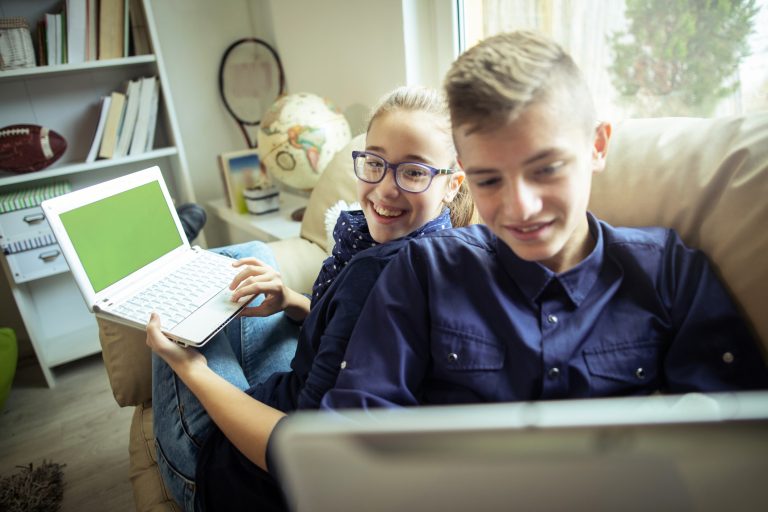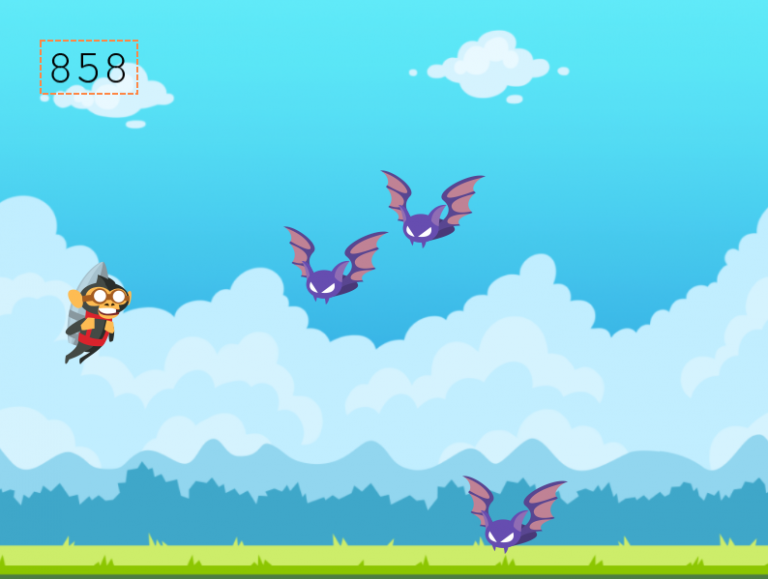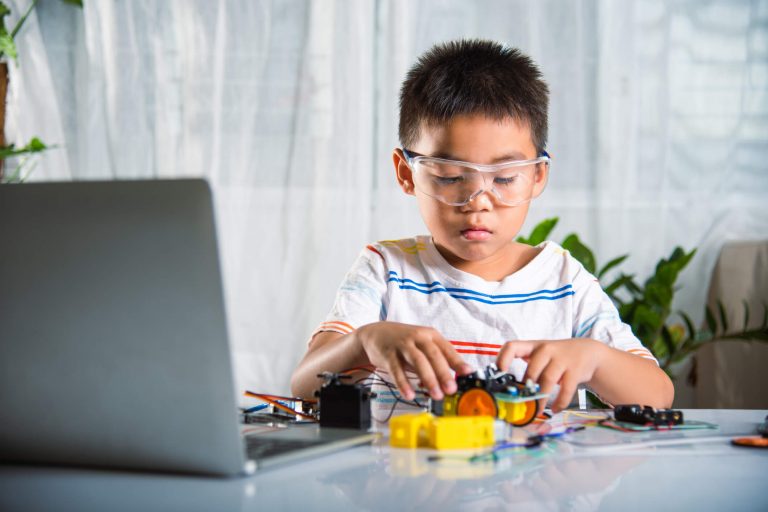Middle school science fairs and hands-on science lessons are an exciting and immersive part of any student’s education, and there is a great deal of potential to make them super fun!
When first looking into ideas for projects to take on, however, it can feel a little daunting. After all, what experiments strike the perfect balance between fascinating and achievable for young children?
If you’re trying to get started and have hit a bit of a roadblock with those blue-ribbon ideas to inspire future STEM leaders, here are 13 great ideas that are age appropriate while also being interesting and challenging!
Table of Contents
Test How Color Affects Memory
Are specific colors better for your memory? Does it help to write notes and flashcards in one color more than it does with another?
Materials
This is a low-budget project that any student or classroom could take on, requiring only a variety of colored pens or markers, index cards and participants.
Procedure
- Gather willing participants (classmates, teachers, etc.) and select a few obscure dates from history.
- On three sets of index cards, write the dates on the front and the event that corresponds with the dates on the back. One group should be in black marker, the second should be in a color that matches the emotional response to an event (red for danger, green for growth, etc.) and the third should be a different, randomly chosen color.
- Divide participants into the control group, the trend group and the random group. Give them all time to study the cards and then test their memory either through written or oral examination.
- The next day, conduct the same test with the participants without giving them additional study time to test long-term memory.
Not only is this middle school science experiment extremely easy to conduct, it can also help students learn potential vital study skills for any subject area in their future!
Use Charcoal to Purify Water
Water filtration systems are extremely common nowadays, but to many it’s a complete mystery how they actually work!
Materials
This is a fairly simple experiment as well, so you’ll only need a measuring cup, a teaspoon, two baby food jars, water, activated charcoal and red food coloring.
Procedure
- Fill the measuring cup with ½ cup of water and add 8 drops of food coloring. Pour half of the mixture into each of the jars.
- Add 2 teaspoons of activated charcoal to one jar and put the lids on both jars. Leave them in a place where they will be undisturbed for several days.
- Note the colors of the jars after 4 hours, 24 hours and then once a day for the remaining three days.
This experiment is great because it is simple, exciting and can be completed in a fairly short time frame. Plus, students will have an added appreciation for the importance of clean, filtered water!
Experiment with Crystals
Crystals are easy to grow and a lot of fun for young students. Plus, there are many ways you can experiment with them during and after the growing process!
One specific way we can explore is aiming for a specific shape and end-product by making a crystal flower.
Materials
Either a real or fake flower will work for this experiment, but you do need a physical one to start one. If it is weak, you will want a pipe cleaner to support the weight. Other than that, all you will need is borax, hot water and food coloring.
Procedure
- Pour boiling water into a cup or jar large enough to hold the flower.
- Stir in borax until it is finished dissolving and add food coloring.
- Place the flower into the cup and let the crystals grow for anywhere between a few hours and overnight (the longer you give, the thicker the crystals will be).
- Remove the crystal flower from the cup and place it on a paper towel to dry!
This is an extremely basic and easy experiment with exciting and beautiful results, so it can make for a fantastic classroom activity!
See How Sugary Drinks Impact Teeth
Everyone knows the general concept that sugary drinks like soda and juice are terrible for your teeth and several other areas as well, but what if we could show young students just how bad they are?
Materials
The basic materials required here will be five eggs, five cups and masking tape. In terms of the drinks you’ll need, make sure to gather water, a dark sugar-free drink like gatorade, a dark juice like grape juice, a dark soda like cola and orange juice.
Procedure
- Fill and label each cup with the name of their respective contents.
- Add the eggs and leave them in a safe spot. Be sure to check every few hours to record any noticeable updates.
- After 24 hours, take out the eggs. Since eggshells have a similar calcium makeup to enamel, the effects that each drink has on the shell will give a general intensified idea of how they impact teeth.
Not only will this experiment help to give students a general understanding of how sugary drinks can impact their teeth, it may inspire them to scrub a little more thoroughly every time they brush!
Make a Hanging Compass to Understand Magnetism
If the science behind magnets is something that interests your students or is relevant to your curriculum, a hanging compass experiment may be the perfect way to go!
This will help them understand the Earth’s magnetic field as it influences the needle of the compass.
Materials
All that will be needed here is a magnet, a large steel sewing needles, a few smaller steel needles, pencil, a string and a wide-mouthed jar or cup.
Procedure
- Rub the pointed end of the large needle on one end of the magnet 30-50 times to align the electrons in the needle and magnetize it. You can test this with the smaller needles by trying to gentle pick them up with the large needle (if it does not work, repeat this step).
- Knot one end of the string around the middle of the needle and the other end around the middle of the pencil.
- Lay the pencil across the mouth of the jar with the needle inside. The needle will turn to point North.
And just like that, you created a compass! This is a great hands-on way to show how magnetism works with the Earth’s natural magnetic field.
Copper Plate Coins
This is a fun and creative way to learn how to use simple, common items to plate coins with copper. You can even incorporate unique designs into the finished product!
This is all done through electricity and can both make for a fascinating individual project or a part of a core lesson plan.
Materials
The materials required for this can be found in most homes or a quick trip to a dollar store. You’ll need a plastic cup, distilled white vinegar, two alligator clips (one red and one black), two copper strips, a nickel or quarter, a 9v battery and battery snap, masking tape, scissors and rubbing alcohol.
Procedure
- Fill the cup with vinegar to a point that is about 2 in. high. Mark a small piece of tape with “+” and another with “-” to tape to either side of the cup.
- Clip a copper strip to the end of each alligator clip.
- Submerge the copper strips and tape the clips in place to keep them out of the vinegar.
- Place the battery into the battery snap and connect the black alligator clip to the black wire lead and the red clip to the red wire lead.
- Wait three hours until the vinegar is a greenish blue. Clean the coin with rubbing alcohol and take the positive alligator clip and copper strip out of the vinegar, replacing with the coin and submerging.
- Wait about 15-20 minutes before taking the coin out and drying it on a paper towel. The coin will now be copper plated!
If you are feeling particularly creative with this project, you can tape neat designs onto the coin to get a fun pattern or look with the plating.
Test How Oil Spills Impact Wildlife
Something that can really hit home for students is how their environment is being impacted by the actions of humans.
Specifically, we have already witnessed the disastrous effects of oil spills in recent history, so showing students just how it impacts our wildlife can help to further emphasize it.
Materials
All you will need here is water, liquid soap, corn oil, vegetable oil, a toothbrush and a feather. The feather is intended to represent wildlife like birds who are commonly affected by these accidents.
Procedure
- Make a chart with the titles “Absorbed,” “Repelled” and “Changes” written across the top and “Water,” “Oil” and Liquid soap along the left side. Draw lines to form a grid.
- Dip the feather in water and record whether it was absorbed or repelled. Note any changes.
- Do the same with the oil and note whether there are any differences. Try to sprinkle water on the oil-soaked feather and note whether the water is absorbed or repelled this time.
- Add some soap to the water and try to scrub off the oil with the soapy water and toothbrush.
- Note how easy or difficult it was to clean the feather and how successfully it was able to return to its original state (or if it wasn’t).
This experiment will show how oil can compromise a feather’s ability to maintain warmth and dryness, showing the importance of caring for our environment and keeping these spills from happening in the first place as much as we can!
Design a Solar Oven
Solar energy in general is becoming a much more popular and necessary source of electricity.
Believe it or not, it’s actually pretty easy to demonstrate how it all works to young students and actually have them design their own solar oven that can be used while camping or simply trying to cook with greener energy sources!
Materials
To tackle this experiment, you will need a cardboard pizza box, a pencil, a ruler, scissors, foil, clear tape, black construction paper, plastic wrap, newspapers, an oven mitt, a dish, a thermometer and cooking ingredients (avoid raw meat)!
Procedure
- Make sure to clean the pizza box before use in case of any leftover cheese or crumbs. Use the pencil and ruler to draw a square one inch from the top of the box.
- Cut out three of the four sides of the square. Crease the uncut side to create a flap that stands up.
- Cut a piece of foil to use to cover the inner side of the flap. Wrap it tightly and secure it with tape.
- Line the bottom of the box with the black construction paper.
- Cut two pieces of plastic wrap the same size as the top of the box. Secure them to the inside edges of the square window with tape so that it is airtight.
- Roll the newspapers into tubes to stuff into the sides of the box (it should still be able to close).
- Use the oven and the sun to cook something (preferably between 11 A.M. and 2 P.M.)!
While this project may take some time, it is definitely something any young student can tackle. Plus, it produces some exciting and delicious results!
Determine Whether Texting is a New Language
Texting has become such an integral part of our society’s communication particularly for younger generations.
Can it be considered a new language, though?
Materials
All that is needed for this project is a computer with internet access, a mobile phone, a digital camera and typical office supplies like paper, pens and poster board.
Procedure
- Read overviews of relevant research and topics. Basic research surrounding linguistics and text messaging are fairly easy to find and understand.
- Compile a text messaging glossary. This can be accomplished through students’ basic knowledge of texting rhetoric as well as some more searches for common phrases, spellings and acronyms.
- Design a new text messaging application and interpret findings in a detailed report. Show these findings visually through charts and graphs.
While this experiment may not concern commonly relevant subject areas, it can easily tie into more social areas of science such as linguistics and communication as well as lead into topics surrounding technology.
Dissect a Flower
Dissection of any organism can do a great job at explaining anatomy to students in a hands-on and visual way that lectures don’t provide.
That said, it can be hard to acquire and dissect animals like frogs or sharks, especially when it comes to younger classrooms. Plus, these projects can turn some stomachs at any age group. Flowers, however, are easy to obtain and have just as much educational potential!
Materials
For this, you will need flowers with easily identifiable parts. This could be something like a hibiscus, for instance, or any flower that will clearly display the anatomy being taught. You will also need a scalpel, pins and materials to draw and label the parts of the flower as students discover them.
Procedure
- Carefully instruct students how to properly use a scalpel to make educated incisissions and locate relevant parts of the flower like the pistil, stamen and others.
- Use the pins to keep the flower open and make it possible to really study the insides of the plant. During this time, students can draw what they are seeing and label each part as they are able to identify it.
- Chart the different lengths of the flowers each student is dissecting to open up discussion on how these differences may have occurred and how they make impact the flowers’ fertility.
Of course, it’s always interesting to move onto other more complex dissections, but this is a great place for students to start!
Create a Homemade Thermometer
Thermometers have been such a basic part of so many areas of society for so long now, including health, environmentalism and more.
It’s also much easier than you may think to make your own!
Materials
To take this on, you will need some basic materials like modeling clay, red food coloring, water, rubbing alcohol, a clear straw, a clear plastic bottle and a thermometer for reference.
Procedure
- Pour equal amounts of water and rubbing alcohol into the bottle until it is a quarter of the way full.
- Add a few drops of food coloring and shake to mix.
- Insert the straw and wrap modeling clay around part of the straw and the bottle opening to ensure that it stays put. Do make sure to leave the opening of the straw uncovered.
- Test the thermometer by wrapping hands around the bottle and seeing what happens as it heats up! The mixture will expand from the heat and cause the red liquid to raise up in the straw.
This is an incredible safe and easy way to make your own thermometer, and it opens up the possibility for discussion with how heat can impact substances!
Use Cabbage to Test pH
Understanding pH levels and the concepts of acids and bases is a part of pretty much any middle school science curriculum.
To make it fun, though, you can help your students learn how to test pH levels by using a cabbage!
Materials
This can be done by acquiring a red cabbage, a pot, water, test tubes, eye droppers and household items to test such as bleach, orange juice, cola, shampoo and window cleaner.
Procedure
- Chop up the red cabbage and put it in a pot, covering it with water. A quarter of the cabbage is sufficient for around three different substances you could test.
- Cook over medium heat until the water absorbs the purple hue (around 15 minutes). Strain the cabbage and reserve the water.
- Fill up the test tubes about a quarter of the way with the cabbage indicator. Adding acids will turn the solution red while adding bases will turn it a greenish tint.
- Use a worksheet to record the pH of however many substances you test!
While this may not be perfect in determining the precise number on the pH scale, it is a fun and interesting way for students to discover the general level of acidity of items that may be hard to otherwise assume!
Test How Caffeine Impacts Typing Speed
Coffee and tea are a big part of many people’s productivity. It can, however, give us jitters and make us feel a little faster with things than we otherwise would.
Does this extend to things like typing speed?
Materials
All that is needed for this is a computer, a caffeinated beverage such as coffee or soda, a non-caffeinated beverage like water and a stopwatch or timer.
Procedure
- Have the test subject drink the non-caffeinated beverage and wait 30 minutes.
- Type a common speed-testing phrase like “the quick brown fox jumped over the lazy dog” as many times as possible for two minutes. There are many word processing programs to more accurately test this as well!
- Drink the caffeinated beverage and wait 30 minutes (it usually takes about 30-45 minutes for caffeine to hit).
- Repeat the typing exercise and compare the results. You can calculate words per minute by dividing the total number of words by the number of minutes.
- Repeat the experiment twice more to ensure accuracy.
Typing and caffeine are both extremely relatable in modern society. This is a simple and great way to help younger students grasp a general idea of how caffeine can really impact us in a way they can understand easily.
In Summary
Finding the perfect science fair experiment or class activity for a middle school age group can be difficult. You want it to be challenging and exciting, but you also want it to be manageable for younger students.
As mentioned, some fantastic ideas include:
- Test How Color Affects Memory
- Use Charcoal to Purify Water
- Experiment with Crystals
- See How Sugary Drinks Impact Teeth
- Make a Hanging Compass to Understand Magnetism
- Copper Plate Coins
- Testing How Oil Spills Impact Wildlife
- Design a Solar Oven
- Determine Whether Texting is a New Language
- Dissect a Flower
- Create a Homemade Thermometer
- Use Cabbage to Understand pH
- Test How Caffeine Impacts Typing Speed
Whether you choose a project from here or elsewhere, it’s great to incorporate it into your agenda! What experiment will you add to your curriculum to crank up the excitement?

















